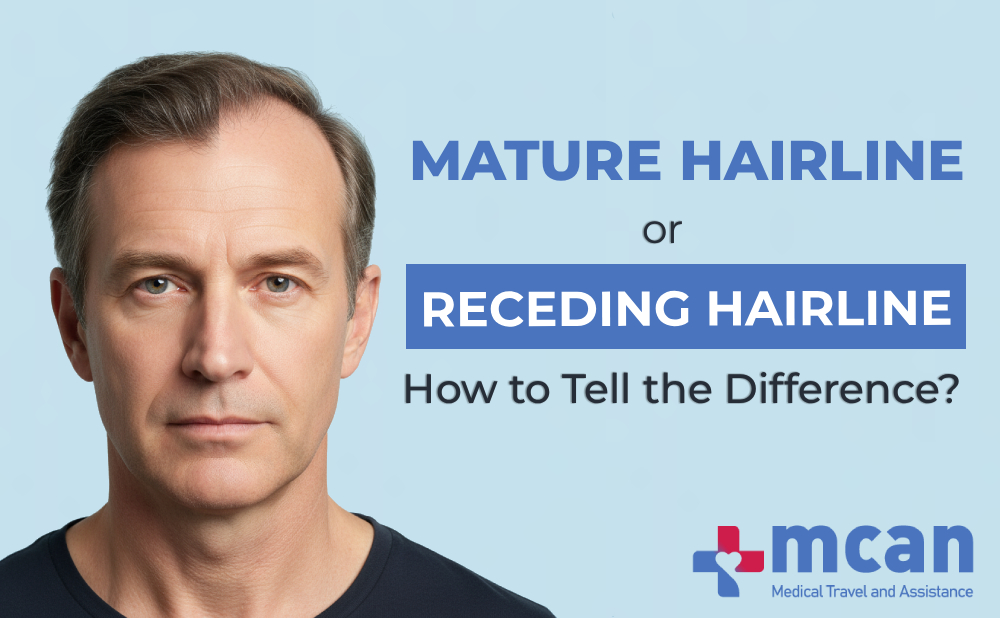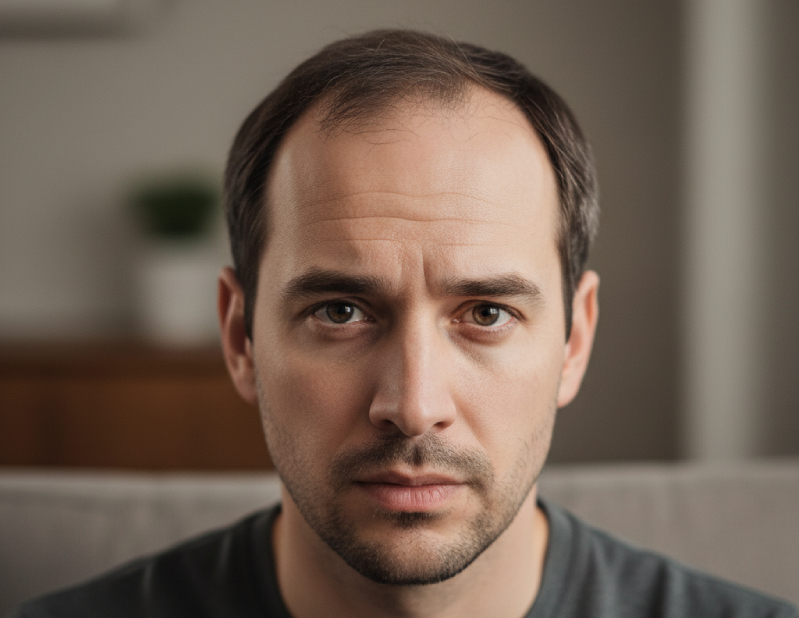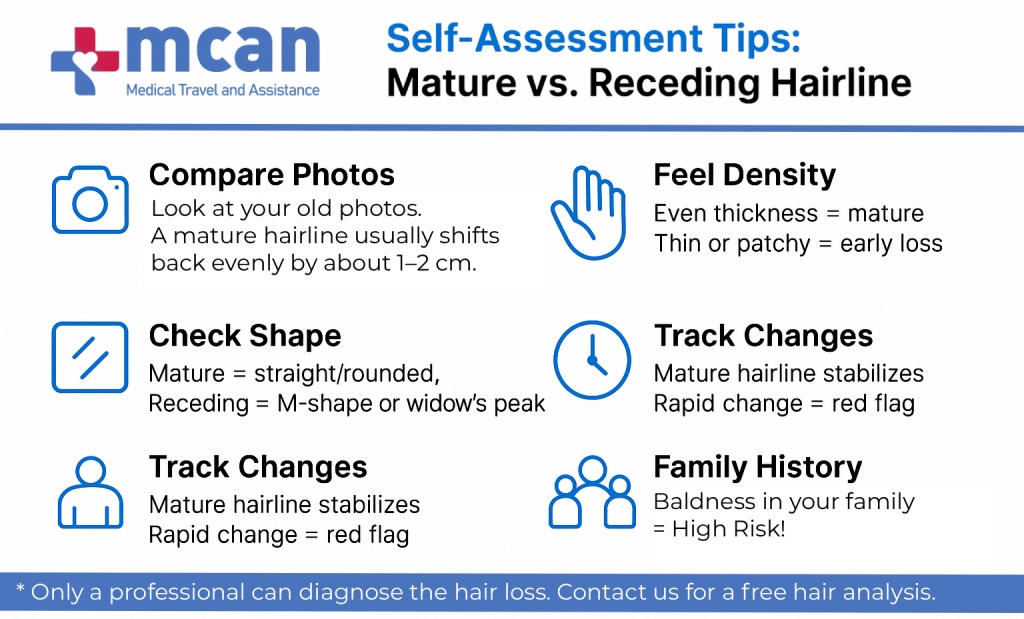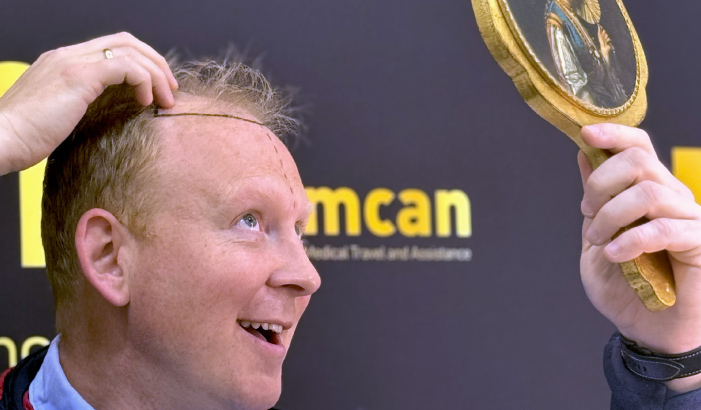
It’s common to look in the mirror, notice a change in your hairline, and immediately wonder if it’s the start of balding. In reality, not all hairline changes are signs of hair loss. For many men, and some women, a slight shift in the hairline is simply part of normal ageing, known as a mature hairline.
The challenge is that a mature hairline can sometimes look similar to the early stages of a receding hairline, which is usually linked to progressive hair loss. Knowing the difference can save you unnecessary stress, help you monitor changes accurately, and guide you toward the right preventative or restorative steps.
This article explains what a mature hairline is, how it differs from a receding hairline, and how to recognize the early warning signs of pattern hair loss. We’ll also share self-assessment tips, explore treatment options for a receding hairline, and discuss when a hair transplant in Turkey with MCAN Health might be the right choice for restoring your hairline.
What Is a Mature Hairline?

A mature hairline is a natural stage in hair development that typically appears in the late teens to mid-20s. It marks the transition from the lower, rounded juvenile hairline you had as a teenager to a slightly higher and more defined adult hairline. Genetics, hormones, and changes in the body influence this shift in facial structure as you age.
Typical Features of a Mature Hairline:
- Slight Recession from Juvenile Position: Usually about 1–2 centimetres higher than your teenage hairline.
- Symmetrical Shape: Both sides move back evenly without irregular patterns.
- Stable Density: Hair remains thick, with no visible thinning or patchiness.
- No Additional Hair Loss Areas: Crown and mid-scalp remain unaffected.
- Slow or No Progression: Once the mature hairline is established, it often remains unchanged for decades.

What Is a Receding Hairline?

A receding hairline is a progressive thinning and backwards movement of the hairline, often caused by androgenetic alopecia (male or female pattern baldness). Unlike a mature hairline, which stabilizes after shifting slightly, a receding hairline continues to move further back over time if untreated. This is often linked to hereditary conditions such as male pattern baldness, which we explore in detail in Male Pattern Baldness: What Is the Cause of Male Pattern Baldness?.
The recession typically starts at the temples, creating an M-shaped pattern in men, while in women, it may present as diffuse thinning along the frontal hairline. This change is more than cosmetic; it reflects an underlying miniaturization of hair follicles triggered by DHT (dihydrotestosterone) sensitivity.
Common characteristics of a receding hairline include:
- Progressive movement backward over months or years, not stopping after a small shift.
- Visible thinning of hair density near the temples, sometimes accompanied by a widening forehead.
- Miniaturized hairs that looks shorter, finer hairs replacing once-thicker strands.
- Family history of pattern baldness which increases the likelihood of progression.
Key Differences Between a Mature and Receding Hairline
While both involve a change in the hairline’s position, the pattern, speed, and accompanying signs help differentiate a normal maturing process from the early stages of male pattern baldness. Understanding these differences can guide you toward the right action, whether it’s simple monitoring or early treatment.
| Feature | Mature Hairline | Receding Hairline |
|---|---|---|
| Age of Onset | Usually develops between ages 17–30 as a natural part of ageing | Can start as early as the late teens or early 20s, but may progress at any age |
| Hairline Shape | Maintains a relatively straight or gently rounded shape, moving back evenly by about 1–2 cm | Often forms an M-shape or deep temporal recessions, with uneven retreat |
| Rate of Change | Gradual shift over several years, then stabilizes | Progressive thinning and retreat over months or years, often worsening without treatment |
| Hair Density | Hair remains thick behind the new hairline | Noticeable thinning, miniaturization, or sparse patches behind the hairline |
| Family History Impact | Not strongly linked to androgenetic alopecia | Often associated with a family history of male pattern baldness |
| Scalp Visibility | Minimal increase in visible scalp | More scalp shows through, especially under bright light or wet hair |
| Need for Treatment | Usually requires no treatment considered normal | Early treatment can slow progression and preserve density |
For more context on the underlying conditions that can cause hair loss, see our guide Understanding the Different Types of Alopecia.
Self-Assessment Tips to Detect a Mature Hairline and Receding Hairline

Identifying whether your hairline change is a normal part of ageing or an early sign of hair loss starts with careful observation. While only a professional diagnosis can confirm it, the following self-checks can help you spot important differences early:
1. Compare Current and Old Photos
Look at pictures of yourself from different stages of life, especially from the front. A mature hairline usually shifts back evenly by about 1–2 cm, while a receding hairline shows deeper retreat at the temples or uneven loss.
2. Check the Hairline Shape in the Mirror
Stand in front of a well-lit mirror and note the outline. A mature hairline remains relatively straight or slightly rounded, while recession often forms an M-shape or widow’s peak.
3. Examine Hair Density Behind the Hairline
Run your fingers through the first few centimetres of hair behind your hairline. If it feels just as thick as other areas, it’s likely mature. Noticeable thinning or sparse patches suggest early balding.
4. Monitor the Rate of Change
A mature hairline develops slowly and stabilizes, while a receding hairline tends to progress over time. If you see noticeable change within months, that’s a red flag for possible hair loss.
5. Consider Family History
If male pattern baldness runs in your family, you may be more prone to a receding hairline. Combining this with other signs (thinning, M-shape, faster progression) can help clarify your risk.
Treatment and Management Options for a Receding Hairline
If you’ve confirmed that your hairline is receding rather than simply maturing, there are several proven approaches to slow progression, stimulate regrowth, or restore density. Choosing the right option depends on your stage of hair loss, underlying causes, and personal goals.
Medications for Hair Loss
Pharmaceutical treatments can slow or even partially reverse hairline recession, especially when started early.
- Minoxidil (Rogaine): A topical solution or foam that increases blood flow to follicles, prolonging their growth phase.
- Finasteride (Propecia): An oral medication that blocks the conversion of testosterone to DHT, reducing follicle miniaturization.
- Both are most effective when used consistently and under medical supervision.
We cover these treatments and more strategies in How to Stop Receding Hairline: Causes & Treatment.
Platelet-Rich Plasma (PRP) Therapy
PRP uses your body’s healing factors to revive weak follicles and encourage thicker hair growth.
- Involves drawing a small amount of your blood, concentrating platelets, and injecting them into the scalp.
- Often performed in a series of sessions, with visible results typically appearing after 3–6 months.
Lifestyle and Nutritional Changes
Adopting healthy daily habits can support scalp health and complement medical treatments.
- Prioritize a balanced diet rich in protein, iron, zinc, and vitamins A, C, D, and E.
- Reduce chronic stress through relaxation techniques like meditation, exercise, or yoga.
- Avoid smoking and excessive alcohol consumption, as both can impair circulation and hair growth.
Hair Transplant Surgery
For advanced or persistent hairline recession, a transplant offers the most permanent solution.
- Techniques such as FUE, Sapphire FUE, and DHI allow for precise graft placement that mimics your natural hairline.
- Success depends heavily on donor area quality and the surgeon’s expertise.
- Modern procedures involve minimal downtime and can produce results that last a lifetime.
Hair Transplant in Turkey for a Receding Hairline with MCAN Health

If your hairline recession goes beyond the natural maturing process, timely intervention can make all the difference. At MCAN Health, we specialize in restoring natural, youthful hairlines through advanced surgical techniques and a patient-centred approach. Our focus is not just on filling lost areas, but on recreating a hairline that complements your facial structure and looks completely natural.
When you choose MCAN Health for your hair transplant in Turkey, you benefit from:
- Specialized hairline design expertise: Every hairline we restore is planned with precision to match your age, facial proportions, and hair growth pattern.
- Modern surgical techniques: We offer advanced FUE, Sapphire FUE, and DHI methods in accredited, state-of-the-art facilities for maximum graft survival and natural results.
- Comprehensive international patient packages: From airport transfers and accommodation to post-op care, our services are designed for convenience and peace of mind.
- Ethical and personalized planning: We prioritize long-term results, donor area preservation, and realistic expectations to ensure lasting satisfaction.
At MCAN Health, we combine Turkey’s renowned medical expertise with a compassionate, detail-driven approach. Whether your goal is to correct a receding hairline or achieve a more youthful frame to your face, our team is dedicated to helping you restore both your hair and your confidence for years to come.
 DHI vs. FUE: Hair Transplant Procedures Compared
DHI vs. FUE: Hair Transplant Procedures Compared  Female Hair Transplant: Everything You Need to Know Before Treatment
Female Hair Transplant: Everything You Need to Know Before Treatment  How to Lose Belly Fat Like an Absolute Champion
How to Lose Belly Fat Like an Absolute Champion